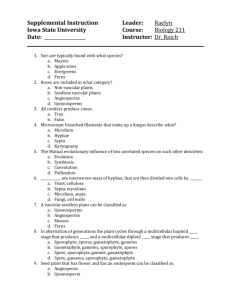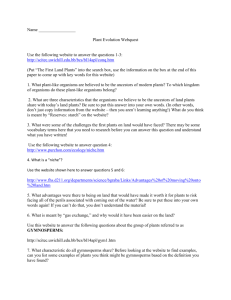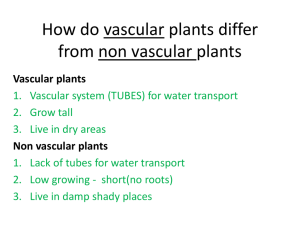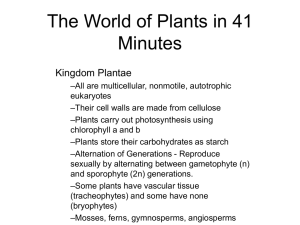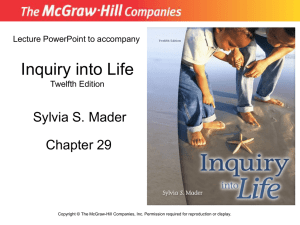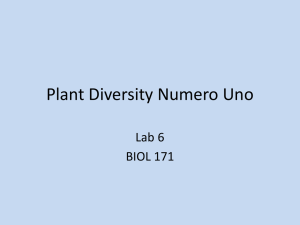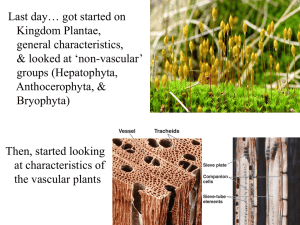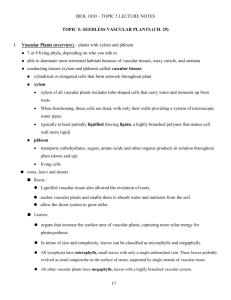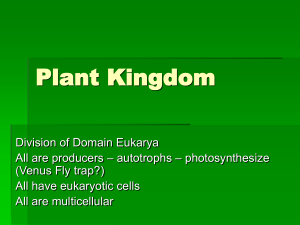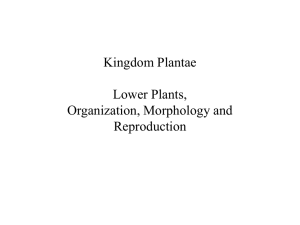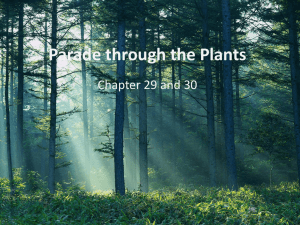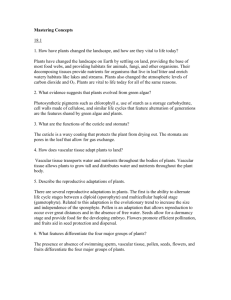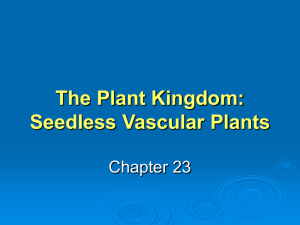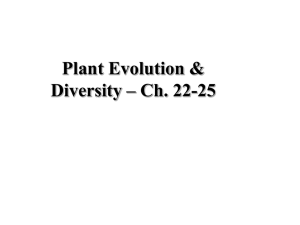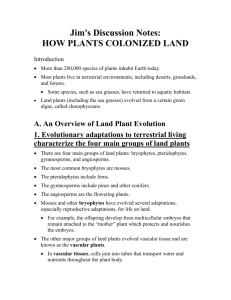Phylum Coniferophyta(구과식물문)
advertisement
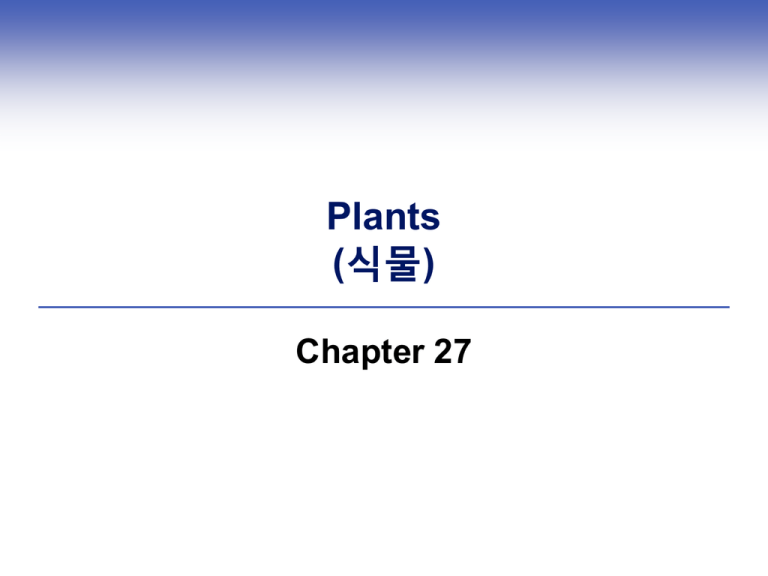
Plants (식물) Chapter 27 육상식물을 대표하는 세 종류의 주요 식물들 – 이끼류(선태류), 구과식물(겉씨식물), 현화식물(속씨식물)-이 있는 온대수림. 27.1 Transition to Life on Land Early biochemical and structural adaptations enhanced plant survival on land Vascular tissue(관다발 조직) innovation for transporting substances within a large plant body Root and shoot systems were adaptations for nutrition and support 27.1 (cont.) In the plant life cycle, the diploid phase became dominant Some vascular plants evolved separate male and female gametophytes Kingdom Plantae(식물계) (1) 300,000 living species, 10 phyla(문) Primary producers, chemical “factories” Adaptations • • • • Avoid desiccation Physical support Nutrient uptake Sexual reproduction without water Kingdom Plantae (2) Plants and green algae share • Cellulose walls • Photosynthetic starch • Chlorophylls a and b Plants evolved from charophyte(차축조) green algae 425-490 mya 그림 27.1. 식물계의 대표들. (a) 바위에서 자라는 이끼, (b) 폰데로사 소나무, Pinus ponderosa는 다른 침엽수와 함께 겉씨식물을 대표, (c) 난초, Cattalya rojo, 현화식물의 좋은 예. Chara, a Stonewort(차축조) 그림 27.2. 차축조. 차축조 계통의 대표적인 식물로서 냄새 때문에 사향초라고 부른다. Adaptations for Plant Survival on Land (1) Sporopollenin(스포로폴레닌) • Resistant polymer, surrounds zygotes of charophytes(차축조), prevents desiccation in plant spores Cuticle(큐티클) • Outer waxy layer, prevents desiccation Stomata(기공) • Passageways for CO2 uptake • Regulate H2O loss Adaptations for Plant Survival on Land (2) Land plants split into bryophytes(선태식물; 선태류) (nonvascular)(비관다발) and tracheophytes (vascular)(관다발식물) Tracheophyte adaptations • Specialized transport cells • Lignin(리그닌; 목질소): Strengthens secondary walls • Apical meristems(정단분열조직): Unspecialized dividing cells, allow branching • Embryophyte(유배식물): Dependent multicellular embryo sheltered inside parent 그림 27.3. 수분 손실을 막기 위한 육상식물의 적응. (a) 표피를 덮고 수분 손실을 감소하는 왁스로 이루어진 큐티클, (b) 잎의 표피(세포의 표면 층)에 있는 기공. Vascular Tissue in Tracheophytes Taller (> 100 m), more complex than bryophytes • Bryophytes lack true roots and stems Need both support and transport efficiency • Xylem(물관부; 목부) transports water and solutes • Phloem(체관부; 사부) transports sugars from photosynthesis Early Vascular Plant Cooksonia 그림 27.4. 최초의 관다발 식물의 하나인 쿡소니아의 약 4억 2,000만 년전의 화석. 줄기 끝의 컵 모양 구조는 생식포자를 만들었음. Root Systems(뿌리계) Roots • Anchor plants • Absorb water and nutrients from soil Rhizome(뿌리줄기; 근경) • Horizontal, modified stem • Penetrates soil, anchors Root systems • Underground, cylindrical absorptive structures Shoot Systems(지상계) Stems and leaves from apical meristems Leaves are modified stems • Two evolutionary paths 그림 27.5. 잎의 발달. (a) 식물의 주축에서 발달한 초기 엽상구조. 오늘날 석송과 같은 무종자 관다발식물은 이러한 잎을 가짐, (b) 무종자 관다발식물의 다른 그룹은 작은 곁가지가 퍼지고 광합성조직이 이들 공간을 채워서 잎몸(엽신)이 되었음. 시간이 지나면서 잎맥(엽맥)으로 변형. Plant Life Cycle(식물의 생활주기) Meiosis produces haploid (n) reproductive cells • Gametes fuse into zygotes Mitosis divides spores into haploid individuals Alternation of generations(세대교번): Cycle between haploid and diploid phases • Sporophytes(포자체) (2n) produce spores in sporangia(포자낭) by meiosis, dominate higher plants (genetic diversity) • Gametophytes(배우체) (n) produce gametes by mitosis 그림 27.6. 식물 생활주기의 기본 패턴인 세대교번의 개요. 식물의 종류에 따라서 반수체와 2배체 세대의 길이는 각각 다름. 그림 27.7. 배우체(반수체) 세대가 우세한 식물로부터 포자체(2배체) 세대가 우세한 식물까지의 진화. 일반적으로 관다발식물의 포자체는 선태식물의 것보다는 크고 복잡. 또한 배우체는 크기가 작고 덜 복잡함. Some Vascular Plants Evolved Separate Male and Female Gametophytes Homosporous(동형포자형) plants produce 1 type of spore • Gametophytes bisexual (sperm and eggs) • Motile sperm require liquid water Heterosporous(이형포자형) plants produce 2 types of spores • Female gametophyte produces eggs, site of fertilization • Male gametophyte (pollen grain) nonmotile sperm transfer into female gametophyte 그림 27.8. 육상식물 주요 그룹 간의 계통발생 관계. 27.2 Bryophytes(선태식물; 선태류): Nonvascular Land Plants(비관다발 육상식물) Liverworts(우산이끼) may have been the first land plants Hornworts(뿔이끼) have both plantlike and algalike features Mosses((솔)이끼류) most closely resemble vascular plants 그림 27.9. 선태식물에서 처음 나타난 배우자를 둘러싸는 다세포 구조. Bryophytes(선태식물; 선태류) (1) Found in wet to moist habitats • Epiphytes(착생식물) grow independently on another organism • Flagellated sperm without vascular system Gametangia(배우자낭) produce gametes in shelter(은신처; 보호처) • Archegonia(장란기) produce eggs • Antheridia(장정기) produce sperm Bryophytes (2) Body plan analogous with tracheophytes(체제가 관다발식물과 유사) • No true roots, leaves, or stems • Gametophyte larger than attached sporophyte Evolutionary position unclear • Could be ancestral to or derived from vascular • Completely separate lineage from vascular • Most evidence shows bryophytes polyphyletic(다계통군) Liverworts(우산이끼) Phylum Hepatophyta(태류문) (liverworts) • • • • Perhaps first land plants Simple thallus(엽상체) (gametophyte) No true stomata Some have gemmae(무성아) (cuplike asexual reproductive structure on thallus)(엽상체 위에 컵 같은 무성생식하는 구조) 그림 27.10. 수배우체(a)와 암배우체(b)를 각기 다른 식물체에서 형성하는 우산이끼(Marchantia). 무성식물의 무성아(c). Hornworts(뿔이끼) Phylum Anthocerophyta(각태류문) (hornworts) • Plantlike and algalike features • Have algalike protein bodies (pyrenoids)(피레노이드) 그림 27.11. 뿔이끼(Anthoceros). 가늘고 긴 포자체의 기부가 평평한 엽상의 배우체에 묻혀 있음. Mosses[(솔)이끼)] Phylum Bryophyta(선류문) (mosses) • Most resemble vascular plants • Protonema(원사체) haploid, filamentous web(망) produces leafy gametophytes[gametophore(배우자(낭)체)라 함] • Leafy moss produces gametangia(배우자낭), may be bisexual or unisexual Few bryophytes have primitive transport cells Ecological functions include soil production and primary producers in harsh conditions 그림 27.12. 솔이끼(Polytrichum)의 생활주기. 27.3 Seedless Vascular Plants(무종자 관다발 식물) Early seedless vascular plants flourished in moist environments Modern lycophytes(석송식물류) are small and have simple vascular tissues Ferns(고사리류), whisk ferns(솔잎란), horsetails(속새류), and their relatives make up the diverse phylum Pterophyta(양치식물문) Early Seedless Vascular Plants Seedless vascular plants release spores and have motile sperm • Sporophyte separates from gametophyte and has vascular tissue First seedless plants: Herbs without woody tissue • Woody(목본성) plants (secondary growth) developed in Carboniferous(석탄기) 그림 27.13. 라이니아(Rhynia), 초기 무종자 관다발식물. (a) 화석에 근거한 식물체의 복원 그림. 약 30 cm 크기, (b) 줄기의 횡단면. Phylum Lycophyta(석송식물문) Lycophytes(석송류) • Vascular seedless plants, club mosses(석송류) • Dominated carboniferous forests as trees, modern small herbs Sporophylls(포자엽) • Sporangia(포자낭) produced on specialized leaves • Cone(구과; 솔방울) or strobilus[구(형)화]: Cluster of sporophylls Gametophyte nonphotosynthetic, requires mycorrhizae(균근) (fungus root) 그림 27.14. 인목(Lepidodendron)의 복원 그림. (a) 화석에 의하면 지름 1 m와 높이 약 35 m로 자랐을 것으로 추정, (b) 석탄기 숲의 그림. 그림 27.15. 석송류. (a) 포자가 만들어지는 원뿔형 구화를 갖는 석송(Lycopodium)의 포자체, (b) 특징적인 Y 형태의 자국(화살표)을 갖고 있는 석송류 포자의 화석. Phylum Pterophyta(양치식물문) Ferns(고사리), whisk ferns(솔잎란), horsetails(속새) • Vascular seedless plants • Abundant during carboniferous as trees • Formed coal fossils (with lycophyta) Complex frond(엽상체)(잘게 갈리진 잎) leaves in sporophyte • Node(마디): Point on stem where leaf attaches • Sorus(포자낭군) on fronds • Annulus(환대)(두꺼운 벽을 갖는 세포열) encloses cluster of sporangia 그림 27.16. 고사리(Woodwardia)의 생활주기. 사진은 호주의 TarraBulga 국립공원의 고사리목(Cyathea) 숲의 일부. Whisk Ferns(솔잎란) Whisk ferns lack true roots and leaves • Rhizoid(뿌리 모양의) mycorrhizal(균근) • Stem epidermal cells conduct photosynthesis • Core has xylem and phloem 그림 27.17. 무종자 관다발식물인 솔잎란(Psilotum)의 포자체. Horsetails(속새류) Horsetails have roots and scalelike(눈금, 비늘같은) leaves • Accumulate silica(규소) • Strobili(구형화) on specialized stems 그림 27.18. 속새류(Equisetum)의 한 종. (a) 영양줄기, (b) 포자낭을 지닌 생식줄기, (c) 생식줄기에 붙어 있는 포자낭의 근접 사진. 27.4 Gymnosperms(겉씨식물; 나자식물): The First Seed Plants Major reproductive adaptations occurred as gymnosperms evolved Modern gymnosperms include conifers(침엽수) and a few other groups Cycads(소철류) are restricted to warmer climates 27.4 (cont.) Ginkgos(은행나무) are limited to a single living species Gnetophytes(마황류) include simple seed plants with intriguing(흥미로운) features Conifers(침엽수) are the most common gymnosperms Gymnosperms(겉씨식물) Naked seed plants • Sporophyte haploid spores retained in reproductive structures Pollen grains(화분; 꽃가루) produce nonmotile sperm • Pollination(꽃가루받이; 수분): Transfer of pollen to female reproductive parts, no water required Ovule(밑씨; 배주) • Sporophyte structure produces female gametophyte with egg • Connected to sporophyte by protective tissue Progymnosperm Archaeopteris 그림 27.19. 화석에 근거해 복원한 데본기의 커다란 원시겉씨식물인 Archaeopteris. 25 m까지 자랄 수 있었으며, 아마도 현대 종자식물의 조상이었을 것임. Seeds Seed structure forms when ovule matures after sperm fertilization through pollination • Embryo sporophyte • Surrounding, nutritive tissues • Protective seed coat Seeds are major adaptations for uncertain environments • Long distance transport • Potential dormancy(휴면) 그림 27.20. 종자의 일반적인 구조. 겉씨식물인 소나무의 종자. Modern Gymnosperms Modern gymnosperms are all woody species 1. Cycads(소철류) (Cycadophyta)(소철문) 2. Ginkgoes(은행나무류) (Ginkgophyta) (은행나무문) 3. Gnetophytes(마황류) (Gnetophyta) (마황문) 4. Conifers(침엽수류; 구과식물류) (Coniferophyta)(구과식물문) Phylum Cycadophyta(소철문) Cycads(소철류) • Flourished during Mesozoic(중생대), now only in tropics • Some have large, cone-shaped(원뿔 모양의) strobili 그림 27.21. 소철류인 Zamia. 끝 부분에 커다란 자성 구과와 고사리 모양의 잎이 특징. Phylum Ginkgophyta(은행나무문) Ginkgoes: One living species, Gingko biloba 그림 27.22. 은행 (Ginkgo biloba). Phylum Gnetophyta(마황문) Gnetophytes(마황류) • Three genera (Gnetum, Ephedra, Welwitschia) • Gnetum and Ephedra both have two-step fertilization like angiosperms 그림 27.23. 마황류(Gnetophytes). (a) Ephedra 포자체의 근접사진, (b) 꽃가루를 형성하는 구과, (c) 종자를 형성하는 구과로서 별개의 식물체에서 발달, (d) 종자형성 구과를 갖는 포자체. Phylum Coniferophyta(구과식물문) Conifers(침엽수류; 구과식물류) (cone bearers) • Woody reproductive cones(목본 생식성 원뿔) Most are evergreen (shed some but not all leaves each year) • Needle leaves • Many produce resin(수지; 송진) Conifer Life Cycle Haploid microspores(소포자) develop in sporangia on male cones (strobili) from spore mother cells((소)포자모세포) • Undergo mitosis to become winged pollen grain Haploid megaspores(대포자) develop from spore mother cells in ovule • Only one of four megaspores survives • Becomes gametophyte after pollination Pollen tube grows after pollination, stimulates egg production and delivers sperm 그림 27.24. 대표적 침엽수인 폰데로사 소나무(Pinus ponderosa)의 생활주기. 북반구의 우점 침엽수로서 커다란 포자체는 많은 목재를 공급함. 27.5 Angiosperms(속씨식물; 피자식물): Flowering Plants(현화식물) Fossil record provides little information about the origin of flowering plants Angiosperms are subdivided into several clades(생물군), including monocots(외떡잎식물; 단자엽식물) and eudicots(진정쌍떡잎식물; 진정쌍자엽식물) Many factors contributed to the adaptive success of angiosperms 27.5 (cont.) Angiosperms coevolved with animal pollinators Current research focuses on genes underlying transitions in plant traits Angiosperms Flowering plants with covered seeds • Carpels(심피; 암술잎) (specialized leaves) protects ovules and seeds • Flowers contain carpels at their center • Fruit structure nourishes and disperses seeds No current firm evidence for evolutionary origins 그림 27.25. 현화식물들. 그림 27.26. 초기 현화식물로 추정되는 Archaefructus sinensis의 화석. 아마도 작은 수생식물이었음. Phylum Anthophyta(속씨식물문) Monocots (single cotyledon) Eudicots (2 cotyledons, 3 grooved pollen grains) Magnoliids(목련아강) Basal angiosperms • Star anise(스타아나이스; 붓순나무) • Water lilies(수련) • Amborella(암보렐라) 그림 27.27. 현화식물의 계통수. Eudicot Pollen 그림 27.28. 진정쌍떡잎식물의 꽃가루. 3개의 베인 상처 같은 발아구를 가짐. 1개의 발아구를 갖는 외떡잎식물을 포함한 모든 종자식물에서 꽃가루 형성됨. 그림 27.29. 기본적인 속씨식물 단일계통군의 예. (a) 태산목(Magnolia grandium), (b) 붓순나무의 일종(Illicium floridanum), (c) 연꽃(Nelumbo nucifera), (d) Amborella trichopoda. 그림 27.30. 외떡잎식물과 진정쌍떡잎식물의 예. Angiosperm Adaptations Efficient transport • Vessel elements(도관요소들) (more efficient than tracheids(가도관)) • More efficient phloem Double fertilization(중복수정) • Produces embryo and endosperm Ovary(씨방) protects ovule • Develops from carpel(심피), turns into fruit 그림 27.31. 현화식물(외떡잎식물인 백합속)의 생활주기. 중복수정이 특징. Coevolution with Animal Pollinators Many angiosperms have specific pollinators instead of just air currents(기류) Pollinators undergo coevolution(공진화) with angiosperms • Heritable change in one affects other Highly specific flowers for pollinators • Bats, bees, beetles, moths, birds etc. 그림 27.32. 현화식물과 동물 수분매개자의 공진화. Evolutionary Transition Genes LFY encodes LEAFY regulatory protein • All land plants have LFY LFY regulation level changes with plant groups • Regulates growth throughout mosses • Subset of tissues in ferns and gymnosperms • Controls floral meristem in angiosperms


